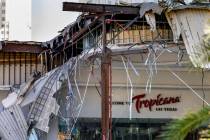How Obamacare will affect ranks of uninsured ‘just speculation’

Mom can’t make you eat your peas.
Your doctor can’t make you lose weight.
And the federal government can’t make you buy health insurance.
Sure, the Affordable Care Act fines people who don’t have coverage after Jan. 1. But experts say the law, commonly called Obamacare, could still leave millions of Americans uncovered as young and healthy consumers choose cheaper fines over expensive coverage.
In Nevada, Division of Insurance spokesman Jake Sunderland said it’s impossible to predict how Obamacare will affect the ranks of the uninsured.
“Any numbers being cited right now are really just speculation,” Sunderland said.
But benefits consultants, insurance carriers and advocacy groups say it’s important to forecast how many people might skip coverage post-reform because the law can’t curb coverage costs if young or healthy people in particular refuse to opt in. Plus, even if they’re healthy, some uninsured Nevadans will unexpectedly need care.
“They still have to get treated. The goal is to get everybody insured so you don’t have the uninsured dragging down the system,” said Michael Caparso, an employee benefits specialist with National Healthcare Access in Las Vegas. “The uninsured person has to pay $2,800 for that MRI that an insured person can get for $400.”
Knowing how many uninsured Nevadans there will be — and who they’ll be — could help public officials and private businesses develop plans to coax them into the market.
NUMBER OF UNINSURED WILL DECREASE
To determine the number of insured post-Obamacare, it helps to know how many Nevadans lack coverage now.
At 22 percent, Nevada placed second for its share of uninsured in 2011, behind only Texas at 24 percent, and well ahead of the 16 percent national average, according to the Kaiser Family Foundation, a California-based health-policy analysis nonprofit group. That meant more than 500,000 Nevadans went without coverage in 2011.
Observers say the number of uncovered in the Silver State will drop dramatically, but hundreds of thousands of Nevadans will still go without policies.
Officials with the Nevada State Medical Association told the Review-Journal in January that they expected 12 percent of the state’s residents would lack coverage post-reform.
Caparso said he expects the number to come in at 11 percent. His company has three people serving on state task forces, through which they’re meeting with public officials and insurance carriers to discuss reform. From those sessions, Caparso’s firm projects 262,000 Nevadans without insurance after January, when coverage mandates kick in.
They’ll be uninsured for a multitude of reasons.
Many simply won’t want to spend money on coverage, Caparso said. Take a casino worker who earns $30,000 a year. Obamacare caps the amount his employer can charge him for coverage at 9.5 percent of his income. That’s $2,850 a year, or $237.50 a month. It would be far cheaper for the employee to skip coverage and simply pay his fine, which would be $95 in 2014.
“The reason some people aren’t insured now is because they don’t want to make a contribution,” Caparso said. “Some employers pay 60, 70 or 80 percent of workers’ premiums, and they still have employees saying they don’t want to pay that remaining portion to have coverage. They’re living paycheck-to-paycheck. They feel invincible, and they’re not buying health insurance.”
Then there will be Nevadans who think they make too much to qualify for Medicaid. What’s more, avoiding the low-income federal coverage program is a matter of pride for some, Caparso said. Still others worry that a speeding ticket or another minor infraction from years ago will pop up in their records if they file for Medicaid.
“Some people just don’t like to be in the system,” Caparso said.
Some people also avoid banks. That could be a problem because many insurers will require customers to pay premiums automatically through a checking account to cut administrative costs, the Jackson Hewitt Tax Service said in a report Wednesday. More than 6 percent of households in the Las Vegas Valley lacked a checking account in 2011, according to the Federal Deposit Insurance Corp. Jackson Hewitt didn’t have local numbers, but said 27 percent of the country’s non-elderly population with household incomes that qualify for tax credits — about $46,000 for a single person and more than $94,000 for a family of four — doesn’t have a checking account.
SOME WORK-BASED INSURANCE WILL CEASE
The state also can expect some people with employer-sponsored coverage to lose their plans. No one has crunched Nevada-specific numbers, but as many as 20 million people nationwide could lose work-based insurance by 2019 in a worst-case scenario tabulated by the Congressional Budget Office in February. Douglas Holtz-Eakin, a former CBO director under President George W. Bush, put that figure at more than 40 million.
The budget office also revised downward its estimated number of Americans who will obtain coverage post-reform. It anticipates 27 million people uninsured before reform takes effect will have coverage by 2017, down from a 2010 forecast of 32 million and a 2011 projection of 34 million. It blamed the decline on haphazard implementation, with some states opting out of public insurance exchanges and Medicaid expansion. Nevada is opting into both.
The expected drop in employer-sponsored insurance would come on top of a long-term decline in office-based coverage. An April study from the Robert Wood Johnson Foundation and the State Health Access Data Assistance Center noted that employer-sponsored coverage among Nevada’s non-elderly population dropped from 70.5 percent in 2000 to 58.4 percent in 2011, a 12.1 percentage-point decline. That outpaced a federal falloff of 10.1 percentage points, from 69.7 percent to 59.2 percent.
A 2011 report from New York consulting firm McKinsey said Obamacare could hasten that decline. The law “minimizes the moral obligation employers may feel to cover the sickest employees, who would otherwise be denied coverage in today’s individual health insurance market,” the study said. And thanks to new coverage mandates and the elimination of lifetime and annual caps on costs, pricier plans will mean at least 30 percent of companies would benefit financially from dropping coverage, even if they paid employees higher salaries or offered other perks instead. Plus, the $2,000-per-worker penalty for not offering coverage is “set significantly below the costs” of complying, McKinsey said.
That’s why 30 percent of employers overall will “definitely or probably stop offering (employer-sponsored insurance) in the years after 2014,” the study said. Among businesses with high awareness of reform, the share is more than 50 percent.
Some of those workers — especially younger, healthier employees — won’t replace their lost coverage through individual markets on state exchanges, Holtz-Eakin found. He conducted a national poll of people ages 18 to 40 in the spring, and found that only 55 percent of them would buy coverage if premiums went up 30 percent. That could be a problem in a market where premiums for people in their 20s could jump anywhere from 42 percent to 149.8 percent, according to groups ranging from the American Academy of Actuaries to consulting firm Milliman.
Finally, expect some Nevadans to cancel new coverage after 2014 because they have trouble getting an appointment with overburdened doctors, Caparso said. People may not think premiums are worth it if they have to wait four months to see their primary care provider.
But state officials, insurance companies and benefits consultants are working to bring the ranks of uninsured below forecasts.
SEARCHING FOR APPROPRIATE SOLUTIONS
Some issues are easier to resolve than others. To help the unbanked, for example, Jackson Hewitt advised the feds to require insurers to accept prepaid debit cards and other forms of payment for those without checking accounts. Fixing the state’s doctor shortage, on the other hand, could take years.
There are other, quicker solutions. For young, healthy workers who don’t see value in expensive coverage, Caparso said “skinny” plans may help. He said insurers are working now on plans that meet required coverage levels, but that save money by offering tiny provider networks. How tiny? Expect fewer than 10 percent of local hospitals and 20 percent of local doctors in your network, or less than a typical HMO offers today. That would bring premiums down to $125 or $150 a month. Someone earning $50,000 a year with an adjusted gross income of $30,000 could pay a 1 percent fine of $300 in 2014, or he could shell out just $700 more for coverage — a deal that might sound a little sweeter.
Nevadans who think they’re ineligible for Medicaid expansion or subsidies to buy on the Silver State Health Insurance Exchange would benefit from counselors or navigators to guide them through the system, Caparso said. The Nevada Department of Health & Human Services plans to hire about 450 people to supplement its current staff of nearly 1,800, said Miki Allard, a staff specialist with the department. Among the hires will be family support specialists who help Nevadans determine Medicaid eligibility.
Employers and benefits consultants can help, too. Companies and their human resources experts need to sit down with every employee and discuss the coverage they’re eligible for.
“If we have to put enrollment people in the casinos around the clock, we will,” Caparso said. “You have to let your employees know the rules, and make sure they understand and sign off on those rules. The only way you can prove you’re in compliance is if your employees sign that sheet.”
Contact reporter Jennifer Robison at jrobison@reviewjournal.com or 702-380-4512. Follow @J_Robison1 on Twitter.


















